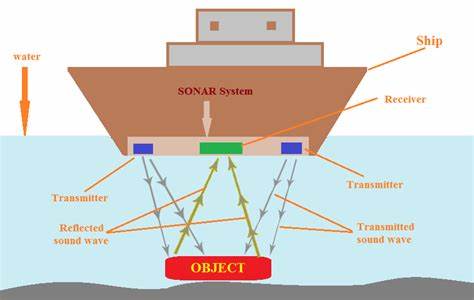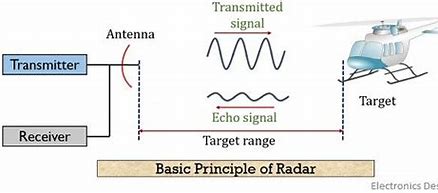1. Introduction
The utilization of sound waves in sonar systems and radio waves in radar systems has experienced rapid development over the past two centuries. Notably, significant advancements have been achieved in the last two decades regarding the remote sensing of various surface parameters within marine environments through the application of high-frequency (HF) Doppler radars [1]. Animals hold significant value, and their distribution and behavior around sustainable ocean energy sources are meticulously studied. This understanding plays a crucial role in anticipating and mitigating potential hazards linked to these installations [2]. Enhancing the Signal-to-Noise Ratio (SNR) can fortify the received signal. Through a method that estimates noise in the first half of the detection coil using data from the second half, it is feasible to determine the transfer function between the reference coil and detection coil. By employing a non-linear fitting method, the UNMR signal is estimated, separated from noise estimates, and preserved within the detecting coil [3].
2. The principle of sonar systems
Sound waves have been utilized for object detection through sonar systems. Searchlight sonar is designed to offer a comprehensive view of the underwater environment surrounding a vessel. The information contained within sound waves, transmitted or absorbed by objects, is analyzed using sonar equipment. A typical sonar system (illustrated in Figure 1) can be divided into three main components: the transmitter, receiver, and acoustic communication systems.
In an active sonar system, the targeted object reflects the emitted sound wave, causing it to spread outward. The reflected signal is captured by the receiver and analyzed. Passive systems consist of a receiving sensor that detects noise generated by the target. Through analysis, it is feasible to identify components, directions, and distances based on the detected waveforms. Acoustic communication systems, constituting the third category of sonar equipment, require projectors and receivers positioned at both ends of the sound transmission line. In a typical active sonar system, the phased array technique is employed, involving the transmission of scaled versions of a single waveform by various array elements. However, the waveform diversity technique necessitates the transmission of multiple distinct waveforms from an array [4].

Figure 1. Sonar system.
3. The principle of radar systems
The radar system (as depicted in Figure 2) is employed for object detection and ranging using radio waves. The distinction between radar and sonar lies in their respective use of sound waves and radio waves; radar is primarily used in the air, while sonar is utilized underwater. Nevertheless, they share a common trait in that they can both be utilized on boats. The functioning of radar is analogous to that of sonar, relying on the principle of wave reflection. The radar system comprises six key components: the sub-trigger circuit, transmit system, transceiver switch, receiver system, radar power source, and antenna system.

Figure 2. Radar system.
Regarding the sub-trigger circuit, it plays a role in controlling the operation of the transmit system, receiver, and monitor. It emits trigger pulses, which upon reaching the transmit system, prompt the immediate generation of a high-power microwave. As the trigger pulse arrives, the pre-modulator produces a small square wave with a specific width. This square wave controls the initiation timing of the square wave generated by the pre-modulator, which subsequently regulates the modulator. Consequently, the modulator produces a high-power, negative high-voltage pulse. Some radar systems lack a pre-modulator, and the modulator performs the function of the pre-modulator. Additionally, a magnetron is present. When subjected to the negative high voltage output from the modulator, the magnetron generates a modulated microwave oscillation pulse. The modulator serves as an equivalent to a high-voltage power supply to achieve energy conversion. During transmission, the transmitter connects with the antenna while the receiver disconnects from it. Conversely, during reception, the receiver connects with the antenna while the transmitter disconnects. Marine radar utilizes microwave bands for the carrier wave. When the target reflects the microwave, the strength of the target's echo is reflected in the envelope of the echo signal. The receiver's task is to detect this envelope. To counter the interference and adverse effects stemming from low-frequency and high-frequency power supply disturbances on a ship's electrical load, marine radars employ specialized medium-frequency power supplies. Presently, radar power supplies primarily employ medium-frequency inverters. The antenna system facilitates the radial transmission and reception of radar microwave signals, with microwave transmission components serving to establish the connection between the antenna and the transceiver. The components utilized in microwave transmission and antenna systems are known as microwave devices. Radars are extensively used on ships. Techniques for ship detection are often based on a constant false alarm rate. However, these methods might exhibit limitations when implemented practically. In instances where a single ship is represented by hundreds of detected pixels in high-resolution radar data, additional post-processing steps (such as clustering) are necessary after detection to generate ship objects, thereby extending the calculation time [5].
4. Signal-to-noise ratio
To enhance the clarity of underwater depiction, it is essential to increase the SNR in sonar systems. The SNR ratio, quantifying the strength of the amplifier's output signal relative to the concurrently produced noise power, is often expressed in decibels (dB). A device's SNR ratio gauges the extent of noise it generates. Generally, better sound quality is associated with a lesser amount of noise intertwined with the signal, resulting in a larger SNR ratio. This ratio serves as a crucial indicator of signal quality. A ratio below 0 indicates that environmental noise surpasses the signal, rendering it barely usable for communication. While some might think signal strength is the primary factor influencing signal quality, even with a potent signal and high noise power, satisfactory communication remains elusive. Given that SNR significantly impacts the quality of sonar communication signals, enhancing the SNR becomes imperative. Over numerous years, pulse compression has found application across numerous fields to bolster SNR and resolution. This technique involves transmitting a modulated or coded excitation [6].
5. The applications of sonar systems
Sonar systems deployed underwater serve a variety of purposes, including detecting unknown objects to prevent potential hazards, mapping the underwater surface, and tracking seabirds or fishes. In this context, a transmitter emits sound waves into the water, which then travel until they reach the underwater surface, at which point they reflect back and are captured by a receiver. As these sound waves propagate, they disperse, and upon reaching the surface, they spread out like a plane. Consequently, the receiver detects a range of different sound waves. By measuring the time it takes for the sound waves to reflect, the distance from the ship to the surface can be calculated. Emitting multiple sound waves in quick succession allows for more accurate mapping of the surface and determining its depth. Moreover, sonar systems can also be employed to detect objects, sharing similarities with mapping techniques.
Historically, sonar systems—employing ultrasound to create detailed images of subsurface areas—have been utilized to identify objects in saltwater environments. These systems are typically affixed to the hull or towed by vessels exploring specific regions. However, due to their limited imaging throughput, covering extensive areas can be time-consuming. Additionally, certain uses of underwater photography can hinder the safe navigation of underwater sonar devices [7]. The transmitter in a sonar system continuously emits sound waves. Another application of sonar technology is in groundwater exploration using nuclear magnetic resonance (NMR), a promising geophysical technique. According to the principles of UNMR (Ultra-Nuclear Magnetic Resonance), the spin rotation axis of hydrogen protons in groundwater becomes altered when energized, leading to observable NMR phenomena [3].
Another valuable application of sonar technology is tracking seabirds and fishes. Fish finders, which are sonar systems, facilitate the identification of fish populations' location, range, and movement patterns. Acoustic barriers have been deployed in marine farms to deter shark intrusions and prevent lobster fish from escaping [7].
6. Limitations and improvement of sonar systems
However, there are several challenges facing contemporary sonar systems. For instance, the commonly used multi-beam bathymetry system employs a method of sideboard installation to circumvent the impact of bubbles generated during navigation on the transducer's ability to transmit and receive energy. To achieve this, the transducer is often submerged underwater at a specific distance. However, this practice results in a blind zone in the bathymetry process, particularly in shallow waters. Consequently, the sonar system struggles to generate images of these areas.
Various strategies can be employed to enhance sonar system performance. Primarily, improving the SNR can enhance communication and enable the receiver to capture clearer signals. The SNR, linked to the power of the output signal and the noise power output, plays a crucial role in signal quality. While amplifying the output signal might seem like a straightforward solution, technical constraints often hinder this approach. Therefore, a more prevalent method involves reducing the noise power output. This is achieved by enhancing receiver sensitivity and utilizing signal processing techniques such as digital signal processing and algorithmic denoising. The signal receiver system itself generates noise, including thermal noise and shot noise in electronic components. These noises exhibit varying intensities at different frequencies. Shifting the original signal to the frequency with the lowest noise intensity in the noise frequency spectrum can mitigate areas with a high noise floor and minimize the impact of interference signals that are not entirely shielded.
In the case of low-frequency sonar pulse signals (DNLS), a detection approach based on a normalized Fourier Transform-Radon transform is provided. This method consistently identifies false alarms within its domain [8]. Signal frequency manipulation is achieved through modulation and demodulation techniques. Contemporary radar encounters challenges in achieving 3D imaging, primarily due to limitations in computer algorithms. However, the advancement of Artificial Intelligence (AI) technology has significantly progressed and can now be broadly utilized in signal processing. For example, Ancuti and colleagues suggested enhancing underwater image quality by combining contrast-enhanced pictures with color-corrected images through a multi-scale fusion technique. In their paper [9], they propose a two-step method for enhancing underwater images, which involves employing a color correction algorithm and a contrast enhancement technique [10].
7. Conclusions
The structure of a sonar system can be broken down into three main components: the transmitter, the receiver, and the acoustic communication systems. This system emits sound waves to aid in the detection of underwater objects, as well as imaging and mapping the surface. The Signal-to-Noise Ratio (SNR) is a critical factor related to the power of the output signal and the level of noise in the output. It profoundly impacts the communication performance of the system. A radar system comprises six essential components: the sub-trigger circuit, transmit system, transceiver switch, receiver system, radar power source, and antenna system. While it shares similarities with a sonar system, there are also notable differences between the two technologies. Despite their usefulness, there are still shortcomings within these systems that need to be addressed. However, there are various ways in which these limitations can be mitigated and the systems improved.



